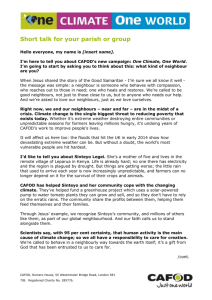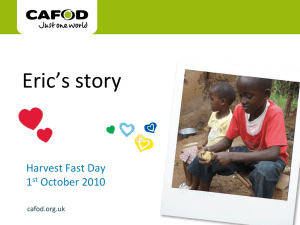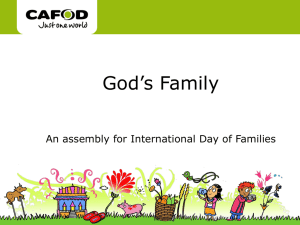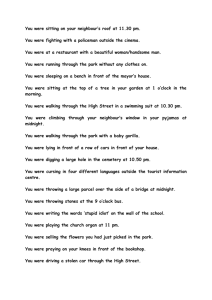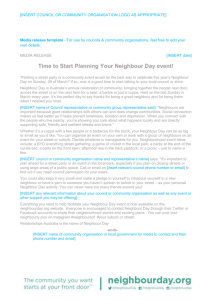Additional materials for Neighbours topic – 'Who is my neighbour?'
advertisement
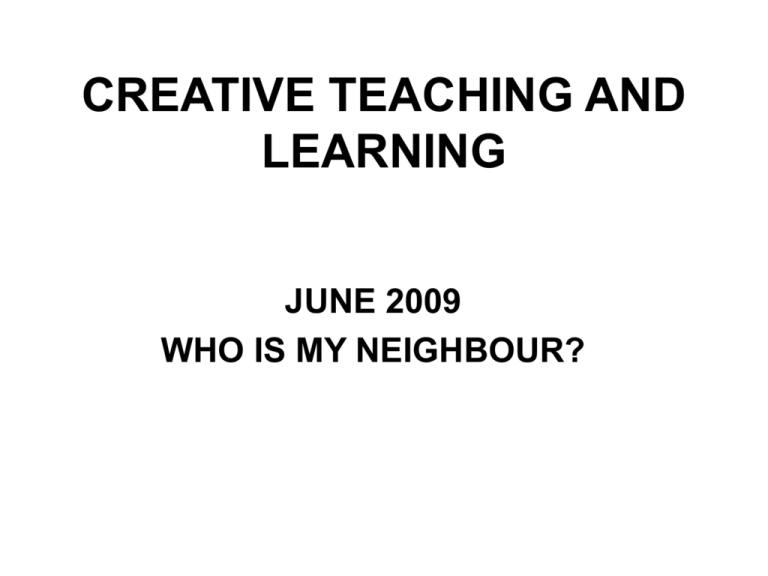
CREATIVE TEACHING AND LEARNING JUNE 2009 WHO IS MY NEIGHBOUR? KEY QUESTIONS What must I do to enable pupils to achieve Level X? How do I create the opportunity for the pupil to begin work at the next level? EFFECTIVE TEACHING AND LEARNING Key factors: • Confident grasp of the subject matter. • Assessment for Learning strategies firmly embedded. • Detailed, rigorous planning to the levels. • High expectations. • Creative, challenging, differentiated, rigorous, enjoyable teaching and learning strategies. TEACHER PREPARATION, REFLECTION AND SUBJECT KNOWLEDGE • What does neighbour mean to you? • How are you a good neighbour? • Brainstorm together any Scripture quotes or stories relating to ‘Who is my neighbour?’ RELEVANT SCRIPTURE • Psalm 18 – ‘..spreading God’s love to neighbours everywhere…’ • Matthew 5: 6-10 – ‘ Happy are those who hunger and thirst for what is right…..’ • Matthew 5: 43-48 – ‘… love your enemies…..’ • Luke 10: 25-37 – Good Samaritan • John 10:10 - ‘I have come that you may have life…..’ • Matthew 22:39 – ‘ You must love your neighbour as yourself.’ • Matthew 25:45 – ‘Whatsoever you do to the least of my brothers and sisters, you do to me.’ • Luke 6:30 – ‘Treat others as you would like them to treat you.’ • John 13: 1-20 – Washing of the Feet PLANNING THROUGH THE LEVELS SOME EXAMPLES FOUNDATION STAGE • Make a big wall picture called: ‘We are all neighbours under one sky.’ • Make a big book of David’s psalm – in groups design a page each like a picture story. Reception could make it for Nursery. Last page can be a picture of all of them, plus pictures of others. • Make a big globe filled with people/faces. • Make a display including photos and annotations about when the children have helped each other. Encourage the children to add to it and include times when they have helped others at playtime or at home. • Play next door neighbour game. Children draw a picture or make something in the make and do area, explain that they are making it for someone but they don’t know who. Children join the circle with their drawing and then explain that they have all brought a gift for the person next to them, their neighbour. LEVEL 1 AT1i- Recognise some religious stories. AT1iii – Recognise that people because of their religion act in a particular way. AT2i – Talk about their own experiences and feelings. Everyone is a neighbour loved by God. • Using King David’s Psalm (18) make a big wall picture of all God’s creation and many different people looking up at it. • Use God’s Story 2 p65 telling Jesus’ teaching on looking after each other. Act out some scenarios of helping each other. Freeze frame, photograph, project onto whiteboard, talk about what is happening. • Write a class Thank You litany about being good neighbours to each other. • Set up a simple radio programme scenario where children talk about how they and others have helped other people. LEVELS 1 & 2 AT1i A Powerpoint presentation of the Good Samaritan can be found at: www.sermons4kids.com/powerpoint_pre sentations.htm It can be used to tell the story visually and use as you wish. Other stories are on the website. LEVEL 2 AT2i – Ask and respond to questions about their own and others’ experiences and feelings. Activity using Art and digital photos. Google a Good Samaritan picture. Arrange pupils as characters in the painting. Photograph them. Interview them. What are the characters thinking, feeling, saying? LEVEL 2 AT1iii – Describe some ways in which religion is lived out by believers. Activity using CAFOD website, DVD ‘One Day One World’ and resource pack – ‘Who Is My Neighbour?’ Working in small groups with the various resources, pupils prepare a presentation in any way they wish describing the work of CAFOD. Each group shares with the rest of the class. LEVEL 2 AT1i – Retell some special stories about religious events and people. Activity using roleplay and Photostory. Read the story of the Good Samaritan from God’s Story 2 using text and pictures. As pupils act out the story, take photos. Using Photostory, write a caption/paragraph sequencing the story. LEVEL 2 AT2i – Ask and respond to questions about their own and others’ experiences and feelings. ‘ A picture tells a thousand words’ Activity using photo galleries/packs. Photo galleries can be found at www.christianaid.org.uk/Teachingresources/primary/photogalleries or CAFOD have photo packs. Pupils take on the role of a person in the photo. In pairs, roleplay a reporter interviewing the person about their experiences and feelings. LEVEL 3 AT1i – Make links between religious stories and beliefs Activity using Art – Good Samaritan painting. Write an article for your local neighbourhood newsletter showing how the Gospel story depicted in this painting is linked to being a good neighbour. LEVEL 3 AT1ii – Use a developing religious vocabulary to give reasons for religious actions and symbols. AT1iii – Give reasons for certain actions by believers. How do neighbouring Christian Churches worship and live out their Christian beliefs? Activity – Venn Diagram Using information gathered from visiting other churches or talking to people from other churches, produce a Venn diagram showing the similarities and differences between how and why different Christian denominations worship and practice their religion. ( Possibility of achieving Level 4 with more depth) LEVEL 3 AT2i – Make links to show how feelings and beliefs affect their behaviour and that of others Activity using digital storytelling – PhotoStory 3 Make links to show how Christian beliefs affect behaviour. Example of activity: Invite visitors into school and ask them questions about how and why they help their neighbours, near and far. Download PhotoStory 3 from www.microsoft.com/windowsxp/using/digitalphotography/photostory/ default.mspx Provide pupils with cameras and recording equipment. In groups, pupils devise a set of questions to ask visitors. Invite visitors. Digitally record interviews. Each group presents their interview to the class. Consolidate findings and summarise as appropriate. LEVEL 3 AT1iii- Give reasons for certain actions by believers. LEVEL 4 AT1iii – Show understanding of how religious belief shapes life. Our neighbours in other Christian Churches. Activity – Prepare an information sheet for parents/carers. Set up interviews/visits with neighbours from other local Christian Churches asking how and why they help and support neighbours near and far. Design and prepare an information sheet to take home. LEVEL 4 AT1i – Describe and show understanding of religious sources, beliefs, ideas, feelings and experiences; making links between them. AT1iii – Show understanding of how religious belief shapes life. Activity – TV Documentary. In small groups, write a script for a TV documentary entitled: ‘Who is my Neighbour?’ Use Scripture sources, websites, CAFOD packs etc Using a camcorder, prepare and record the programme and share it with the class. LEVEL 4 AT1iii – Show understanding of how religious belief shapes life. Activities researching a website. • Write an article for a magazine showing your understanding of how the work of CAFOD is inspired by the Gospels. • Write a letter to your headteacher/parish priest encouraging the school/families/parish to buy fairly traded products. LEVEL 4 AT2ii – Engage with and respond to questions of life in the light of religious teaching. ‘Big Question’ – Why are people poor? Activity using ICT- Prepare a PPT presentation for a school assembly. Using learning from CAFOD resource pack ‘Who Is My Neighbour’ particularly Worksheets 1 & 9, explore the question ‘Why are people poor?’ in the light of religious teaching. In pairs/ as a class/small groups prepare a PPT presentation for a school assembly. LEVEL 4 AT1iii – Show understanding of how religious belief shapes life. Activity – Research the work of aid agencies. Divide the class into groups. Each group research the religious beliefs behind the work of agencies such as SVP, St Cuthbert’s Care, Mission Together, Christian Aid, Oxfam etc. Each group present their findings to the class showing their understanding of how religious belief shapes these organisations. LEVEL 4 AT2i – Show how own and others’ decisions are informed by beliefs and values. Activity – Debate Using the material on Worksheet 10 of the CAFOD resource pack, set up a debate entitled: There will always be poor people. LEVEL 5 AT1ii- Describe and explain the meaning and purpose of a variety of forms of worship. How do neighbouring Christian Churches worship? Activity: Find out how 2 or 3 other churches in your area worship. Ask the ministers or worshippers why they do what they do. Present your findings in a creative way. LEVEL 5 AT2i – Explain what beliefs and values inspire and influence them and others. Activity – Research using the internet. Access the CAFOD website www.cafod.org.uk and make notes on the values which underpin their work. Find out where these come from. Write a letter to CAFOD explaining what values and Scripture inspired your school to raise money for a CAFOD project. LEVEL 5 AT1iii - Identify similarities and differences between peoples’ responses to social and moral issues because of their beliefs. Activity – Venn Diagram Produce a Venn diagram to identify the similarities and differences between how Christians and nonbelievers would respond to the problem of poverty.

